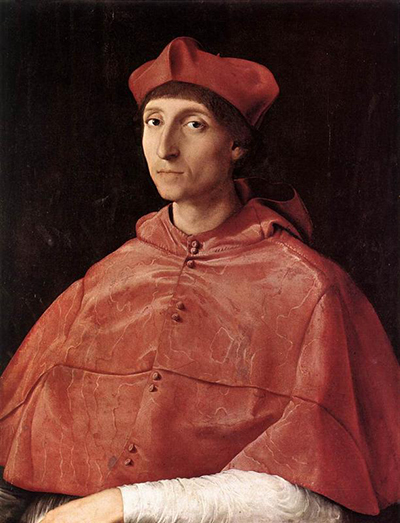The painter Raphael is one of the Italian Renaissance's most important artists. He produced a great number of paintings during his career.
One of those works attributed to Raphael is the Portrait of a Cardinal. It also has the alternative title, The Cardinal. The picture is on display in Madrid’s, Prado Museum. Between 1510 and 1511, Raphael painted the Portrait of a Cardinal. It’s an Ecclesiastical themed portrait of a Rome cardinal. The painting applies the medium of oil on wood. It measures 79cm × 61cm. Raphael painted the picture at a time when he was in Rome and at the height of his career. His patrons during his time in Rome were the popes Julius II and later, Leo X. Over 200 years after its painting, Carlos IV of Spain obtained the work during a visit to Rome as a prince.
The identity of the cardinal in the portrait has been the subject of much effort by art historians. Shown seating, it’s thought that the cardinal is either Cardinal Bendinello Suardi or Cardinal Francesco Alidosi. The painting of the cardinal shows a contrast between the person and the dark background. Equally, there are strong contrasts visible in the cardinal. This is down to the red of his hat and cloak compared with the whiteness of his sleeves and his face. There are no objects in either the background or on the body of the sitter. Some say that their absence makes the presence of this member of Rome’s church all the more striking.
During his career, Raphael painted portraits of many of his friends, family and clergy. Those commenting on his works report how his subjects show a strong sense of realism. In his portraits, Raphael applied a lot of detail to making subjects appear real and encouraged other painters to do the same. Unlike his portraits of friends and family, Raphael’s portraits of members of the church began after he took up residence in Rome. Some of those works include:
- Portrait of Cardinal Alessandro Farnese
- The Cardinal
- Portrait of Pope Julius II
- Portrait of Tommaso Inghirami
- Portrait of Cardinal Bibbiena
- Pope Leo X with Cardinals Giulio de' Medici and Luigi de' Rossi
In his portraits, Raphael was able to express clarity and simplicity in his subjects. He gave his subject's an appearance that allowed them to appear human with a personality. Raphael was a master painter using techniques that we identify today as being High Renaissance. When it comes to portraits, his style and methods enabled him to provide his subjects with a sense of appearing three-dimensional. Raphael's Portrait of a Cardinal has been compared to Leonardo da Vinci's Mona Lisa. The reason being that the cardinal’s body and arms appear to form a triangle pyramid. With his brushstrokes, he brought out the character of his subjects.




